Overview
The article titled "7 Essential Insights on High-Voltage Power Line Inspections" addresses the critical facets and practices necessary for ensuring the safety and reliability of high-voltage power line inspections. It underscores the necessity of:
- Regular inspections
- Strict adherence to regulatory standards
- Effective vegetation management
- Integration of advanced technologies such as infrared imaging
Each of these elements plays a vital role in mitigating risks and bolstering public safety within energy infrastructure.
Introduction
In the realm of energy and infrastructure, the safety and reliability of high-voltage power lines are paramount. As utility companies navigate the complexities of compliance, community engagement, and technological advancements, the stakes have never been higher. Effective tree trimming and vegetation management, alongside innovative helicopter inspections utilizing infrared technology, form a multi-faceted approach essential for mitigating risks and enhancing public safety.
This article delves into the critical aspects of high-voltage power line inspections, exploring the importance of:
- Regulatory compliance
- The potential health risks associated with electromagnetic fields
- Proactive measures that can be taken to ensure the integrity of electrical infrastructure
By understanding these key elements, stakeholders can better appreciate the vital role that rigorous inspection protocols play in safeguarding communities and maintaining reliable power delivery.
Harbinger Land | Comprehensive Solutions for Land Services in Energy and Infrastructure
Navigating the complexities of land services is crucial for energy and infrastructure projects, and Harbinger Land excels in this arena. The challenges of site and right-of-way acquisition, coupled with legal and regulatory hurdles, can be daunting. Harbinger Land addresses these issues head-on with comprehensive offerings that include:
- Title research
- GIS mapping
- Data processing
By harnessing cutting-edge technology, such as AI-driven title research software, Harbinger Land significantly enhances operational efficiency. This innovation not only streamlines processes but also elevates client satisfaction, positioning the company as an indispensable ally for natural gas companies, solar developers, and municipalities.
The seasoned team at Harbinger Land is adept at swiftly mobilizing resources, ensuring that services are delivered accurately and on time. Each project is approached with a tailored strategy, designed to meet specific demands and overcome unique challenges.
In a landscape where timely and precise land acquisition is paramount, partnering with Harbinger Land means gaining a competitive edge. Their expertise and commitment to excellence make them the ideal choice for navigating the intricacies of land services in the energy sector.
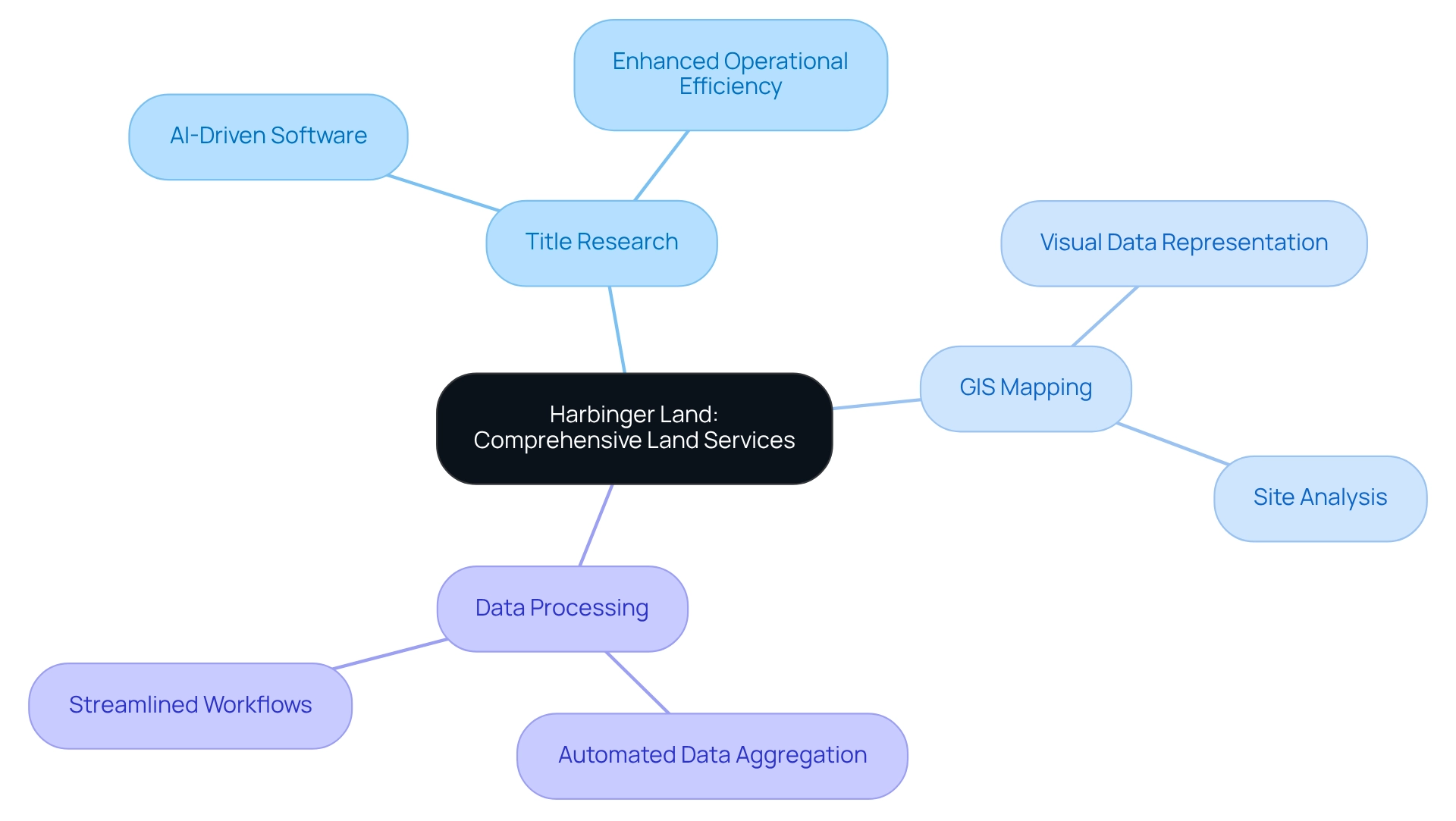
Tree Trimming and Vegetation Management: Ensuring Safety Near High-Voltage Power Lines
Efficient tree pruning and plant management are essential for ensuring safety during high-voltage power line inspections. Utility companies must conduct regular assessments to manage vegetation, preventing interference that can lead to outages or fire hazards. This includes the removal of dead or unhealthy trees and the careful pruning of healthy trees to maintain a safe distance from electrical cables. Adhering to local regulations and safety standards is vital, as it protects both infrastructure and public well-being.
For instance, Oncor's tree planting recommendations encourage customers to plant trees away from existing overhead electric wires, minimizing potential conflicts and enhancing service reliability. Moreover, research indicates that effective vegetation management can significantly reduce the frequency of outages related to high-voltage power line inspections, with a decrease of 0.0000729 outages for each additional meter of TTOs (SMT or ETT) conducted with 99% confidence, underscoring the importance of proactive measures in preserving high-voltage power line integrity.
Utility firms are increasingly implementing effective tree trimming initiatives that comply with standards, ensuring that vegetation management is both efficient and aligned with industry regulations. As noted by Peter L. Watson, the authors found that disruptions were minimized through effective vegetation management, highlighting its crucial role in enhancing safety.
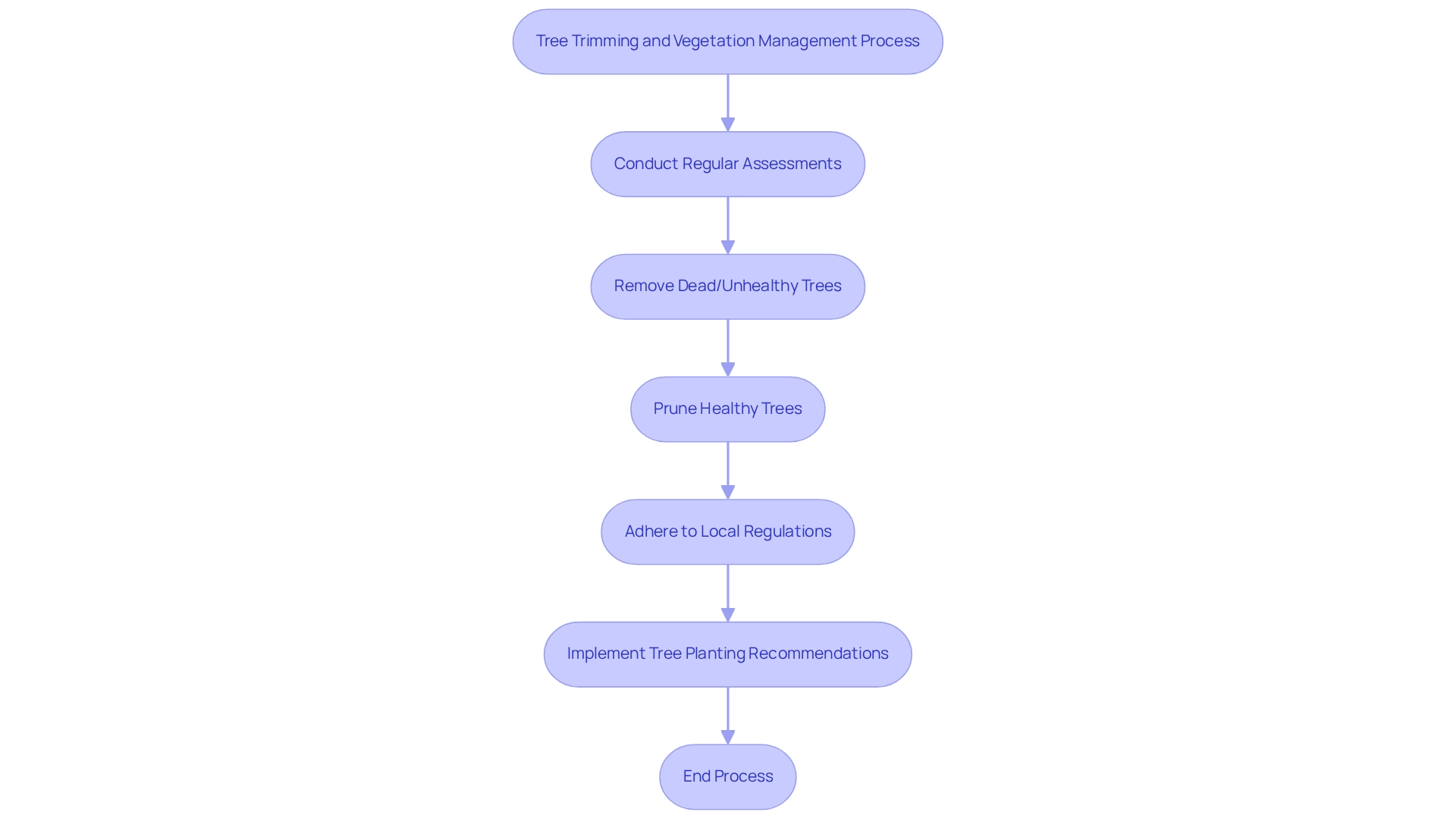
Understanding Electromagnetic Fields (EMFs) and Their Impact Near High-Voltage Power Lines
Electromagnetic fields (EMFs) generated by high-voltage cables significantly impact the surrounding environment and community health. Current research reveals that health guidelines for telecommunications equipment are outdated, necessitating a comprehensive re-evaluation. Studies indicate a potential link between EMF exposure and childhood cancers, prompting urgent calls for further investigation into this critical issue. Utility companies must prioritize monitoring EMF levels and transparently communicate their findings to the public, alleviating community concerns and ensuring compliance with health and regulatory standards.
Monitoring EMF levels is essential, as these fields can penetrate building materials, making indoor measurements crucial. Recent case studies, such as those by L. Lloyd Morgan, an expert in electronic engineering, highlight the potential link between cell phone use and various tumors, citing the influence of industry funding on research outcomes. Morgan advocates for independent studies to uncover the health hazards of microwave radiation and safeguard public health. Statistics show that communities are increasingly aware of the potential health effects of EMFs, leading to heightened scrutiny of utility placements and evaluations.
Utility companies should provide clear, accessible information regarding EMF exposure levels and their implications for public health. Engaging with the community through educational initiatives can foster trust and ensure that residents are informed about the safety measures in place. As Paul J. Rosch, MD, a Clinical Professor of Medicine and Psychiatry, stated, "This gigantic experiment on our children and grandchildren could result in massive damage to mind and body with the potential to produce a disaster of unprecedented proportions, unless proper precautions are immediately implemented."
As the scientific community continues to explore the relationship between EMF exposure and health outcomes, proactive communication strategies will be vital in addressing public concerns and maintaining compliance with evolving health standards.
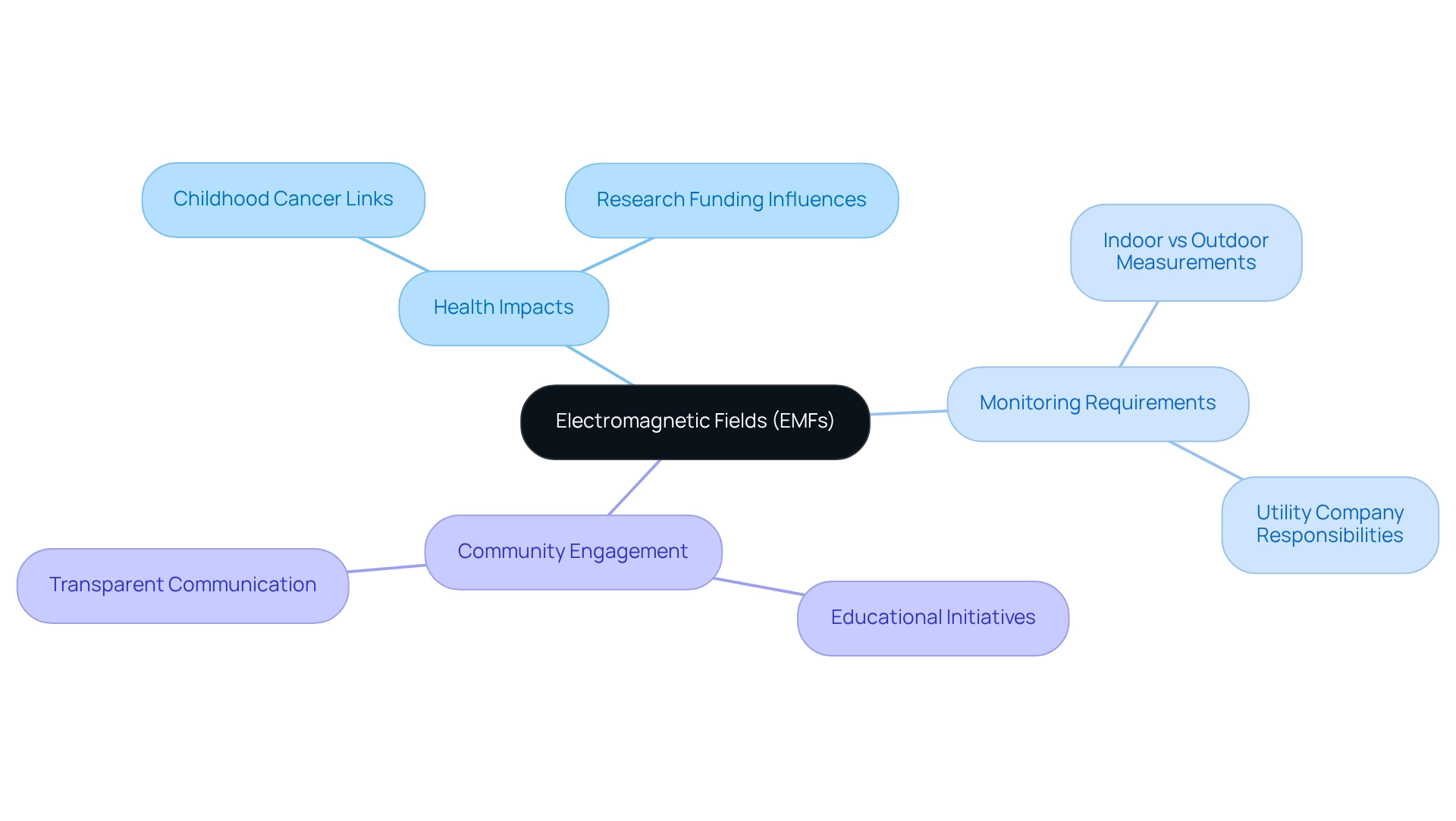
Helicopter Inspections: Utilizing Infrared Technology for High-Voltage Power Line Safety
Helicopter evaluations utilizing infrared technology are rapidly becoming essential for high-voltage power line inspections of transmission cables. This innovative approach allows for swift and comprehensive assessments of extensive power distribution networks, effectively identifying hotspots and potential failures that may elude high-voltage power line inspections. Infrared cameras excel at detecting thermal anomalies, which can indicate problems such as overheating connections or equipment malfunctions. This proactive strategy not only bolsters security and reliability but also significantly mitigates the risk of outages, ensuring maintenance is performed promptly.
For instance, FirstEnergy Corp. has utilized high-voltage power line inspections through proactive aerial surveys covering nearly 5,000 miles of high-voltage cables using both infrared and ultraviolet technology, successfully identifying early-stage equipment issues that could lead to outages. The critical need for efficient monitoring techniques is underscored by the tragic 2016 hot air balloon cable strike incident in Texas, the deadliest in U.S. history since 1964, highlighting the urgent necessity for enhanced protective measures.
Moreover, the International Helicopter Safety Team (IHST) advocates for manufacturers and operators to adopt wire strike protection systems on their helicopters, stressing the importance of safety in aerial operations. Such initiatives illustrate the effectiveness of infrared evaluations in enhancing grid reliability and addressing future energy demands. Additionally, utilities can further improve aviation safety by voluntarily incorporating markers on electrical cables.

Regulatory Compliance: Key Standards for High-Voltage Power Line Inspections
Adherence to regulatory standards is paramount for high-voltage power line inspections, as it profoundly impacts public well-being and operational effectiveness. The Federal Energy Regulatory Commission (FERC) and the North American Electric Reliability Corporation (NERC) establish vital guidelines that utility companies must adhere to, encompassing examination frequency, security protocols, and reporting obligations. Notably, NERC conducts audits of certified enterprises every three years to ensure compliance with these standards. This rigorous oversight is essential, particularly in light of historical events such as the 2003 blackout, which led to the implementation of stringent regulations aimed at enhancing the reliability of the Bulk Power System.
Utility companies encounter persistent challenges in fulfilling these compliance standards due to the intricate nature of the interconnected infrastructure. A case study illustrates that while not all incidents can be prevented, the consistent enforcement of NERC standards significantly mitigates the frequency and impact of compliance violations. Furthermore, following the 2003 blackout, the North American Electric Reliability Corporation (NERC) was designated as the Electric Reliability Organization (ERO), tasked with developing and enforcing standards that ensure the reliability of the Bulk Power System, including vegetation management standards.
Adhering to FERC and NERC guidelines not only safeguards the public but also protects utility companies from potential liabilities, ultimately enhancing their operational efficiency. As the energy infrastructure landscape evolves, it is crucial for utility companies to remain informed about current regulatory standards for high-voltage power line inspections, thereby effectively navigating the complexities of compliance.

Identifying Safety Hazards: Common Risks Associated with High-Voltage Power Lines
High-voltage power line inspections are necessary because high-voltage transmission cables present significant risks that require diligent recognition and oversight. These risks encompass electrical shock, arc flash, and the peril of falling objects. To effectively mitigate these dangers, it is essential to educate both workers and the public regarding the potential hazards associated with high-voltage power line inspections.
Utility firms must prioritize comprehensive training initiatives that adhere to OSHA's QEW standards, ensuring that workers are thoroughly informed about safe practices related to high-voltage power line inspections. High-voltage power line inspections, along with routine security audits, are vital for identifying potential risks and ensuring compliance with regulations.
Alarmingly, statistics reveal that from 2003 to 2009, nearly 70% of documented contact incidents with electrical wires resulted in fatalities, underscoring the urgent need for effective protective measures. Furthermore, case studies such as 'Technological Solutions for Electrical Infrastructure Protection' highlight the importance of protective technologies, including proximity devices and insulated connections. While these advancements enhance security, they do not eliminate the necessity of maintaining adequate clearance from electrical sources.
Additionally, recognizing occasions like National Electrical Safety Month and Fire Prevention Week serves as important reminders to reinforce protective measures. By fostering a culture of safety and vigilance through targeted training and awareness programs, the risks associated with high-voltage power line inspections can be significantly reduced.
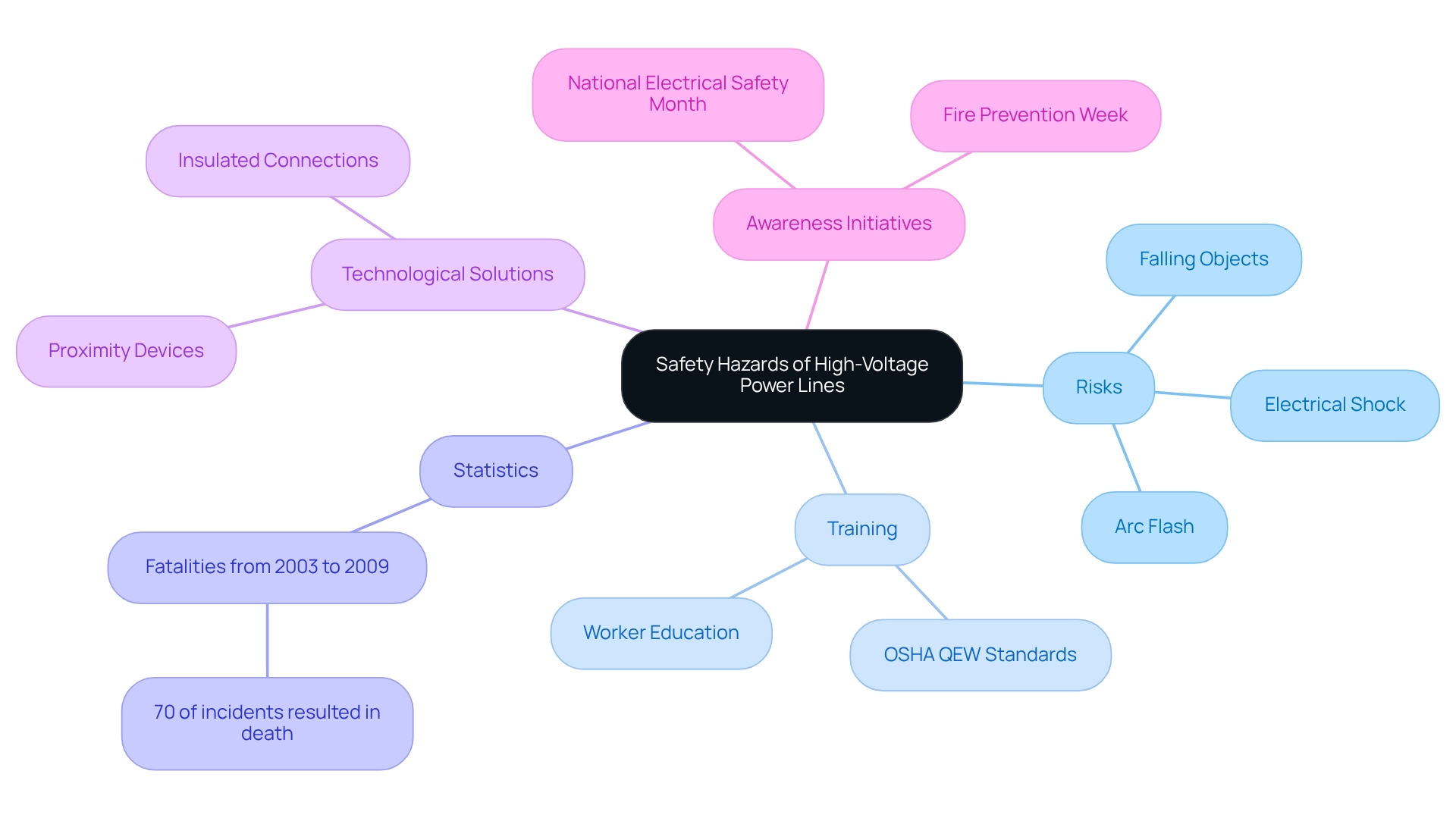
Community Engagement: Promoting Safety Awareness Around High-Voltage Power Lines
Community involvement is essential for enhancing awareness of high-voltage electrical cables. Utility companies must prioritize communication with local residents about the inherent risks associated with power lines. A critical message to convey is that downed power lines should always be assumed live, and approaching them is dangerous.
Effective strategies for engagement include:
- Hosting community meetings
- Distributing educational materials
- Utilizing social media platforms to share vital information
These initiatives not only raise awareness but also foster a culture of safety. For instance, successful awareness campaigns demonstrate that informed and involved communities experience a notable decline in electrical accidents. Furthermore, statistics reveal that active participation in community engagement efforts correlates with a reduction in significant social conflicts, highlighting the importance of collaboration in risk mitigation.
By establishing transparent communication channels, utility companies can build trust and empower community members to report concerns or hazards related to electrical lines, ultimately creating a more secure environment for everyone. As Alexander Eser aptly noted, 'Community engagement is a proven catalyst for stronger communities and enhanced safety awareness.
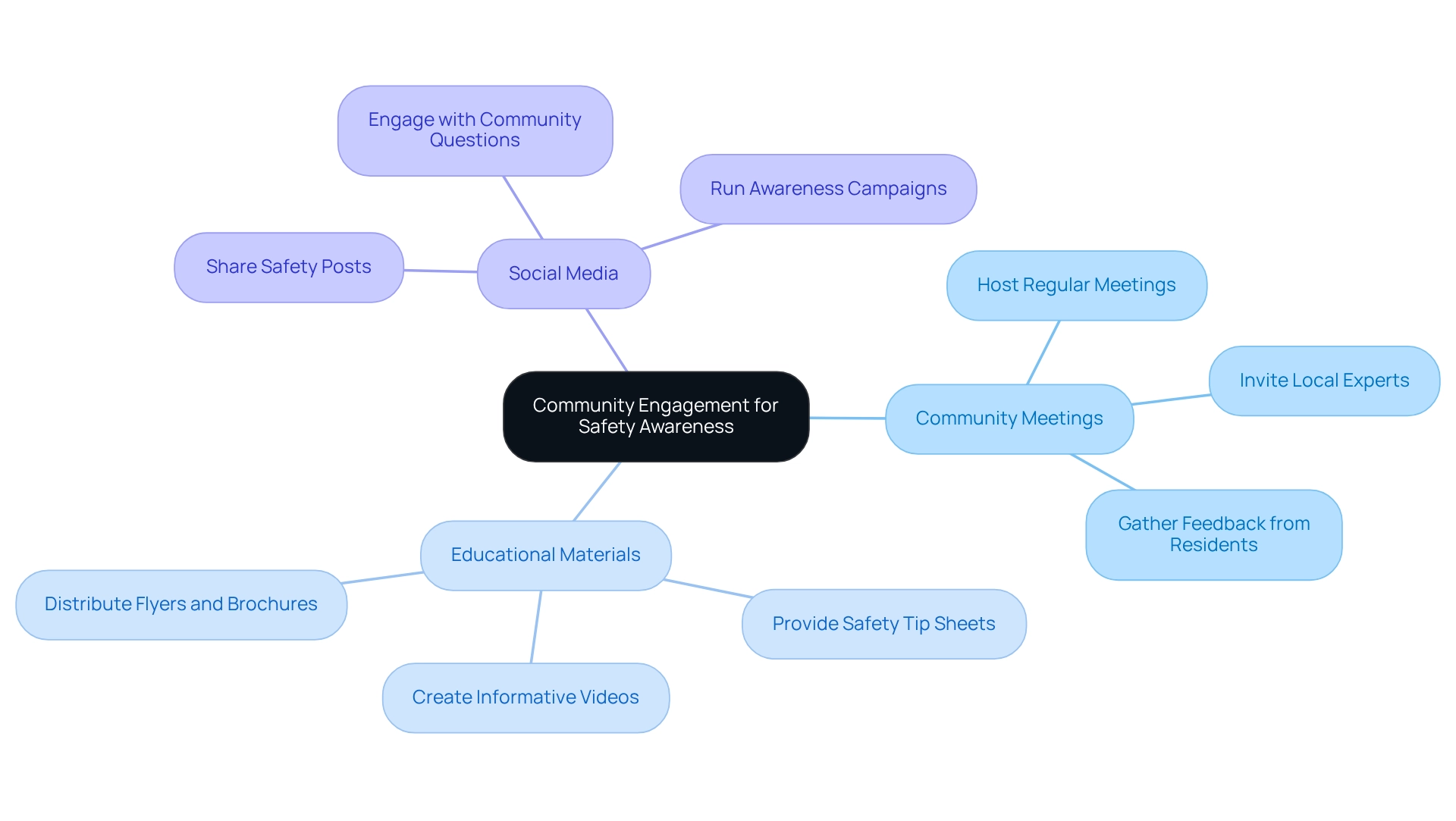
Inspection Frequency: How Often Should High-Voltage Power Lines Be Inspected?
The frequency of high-voltage power line inspections is influenced by several factors, including the age of the infrastructure, environmental conditions, and regulatory requirements. Optimal methods suggest that high-voltage power line inspections should occur at least once a year; however, more frequent evaluations are advisable for lines located in high-risk areas or those that have previously exhibited issues.
Utility providers must establish a robust evaluation timetable that integrates regular assessments with targeted examinations based on specific risk analyses, including high-voltage power line inspections in areas subject to severe weather patterns, which may necessitate more frequent evaluations to ensure safety and reliability. As emphasized by Southern California Edison, a commitment to safety is essential in safeguarding both workers and infrastructure.
Moreover, recent case studies underscore the importance of prioritizing quality over cost in evaluation services. While budget considerations are significant, opting for less expensive evaluation services may lead to incomplete assessments, potentially overlooking critical flaws that could jeopardize infrastructure integrity.
In alignment with industry standards, it is recommended that utility companies capture imagery from multiple perspectives—side views and top-down shots—to ensure comprehensive coverage during evaluations. This approach not only enhances the quality of the assessment but also adheres to regulatory standards designed to protect both employees and infrastructure. Additionally, employing experienced linemen and licensed professionals can greatly enhance service quality and reliability.
By implementing these strategies, utility companies can significantly improve their high-voltage power line inspections, thereby ensuring the safety of the communities they serve.
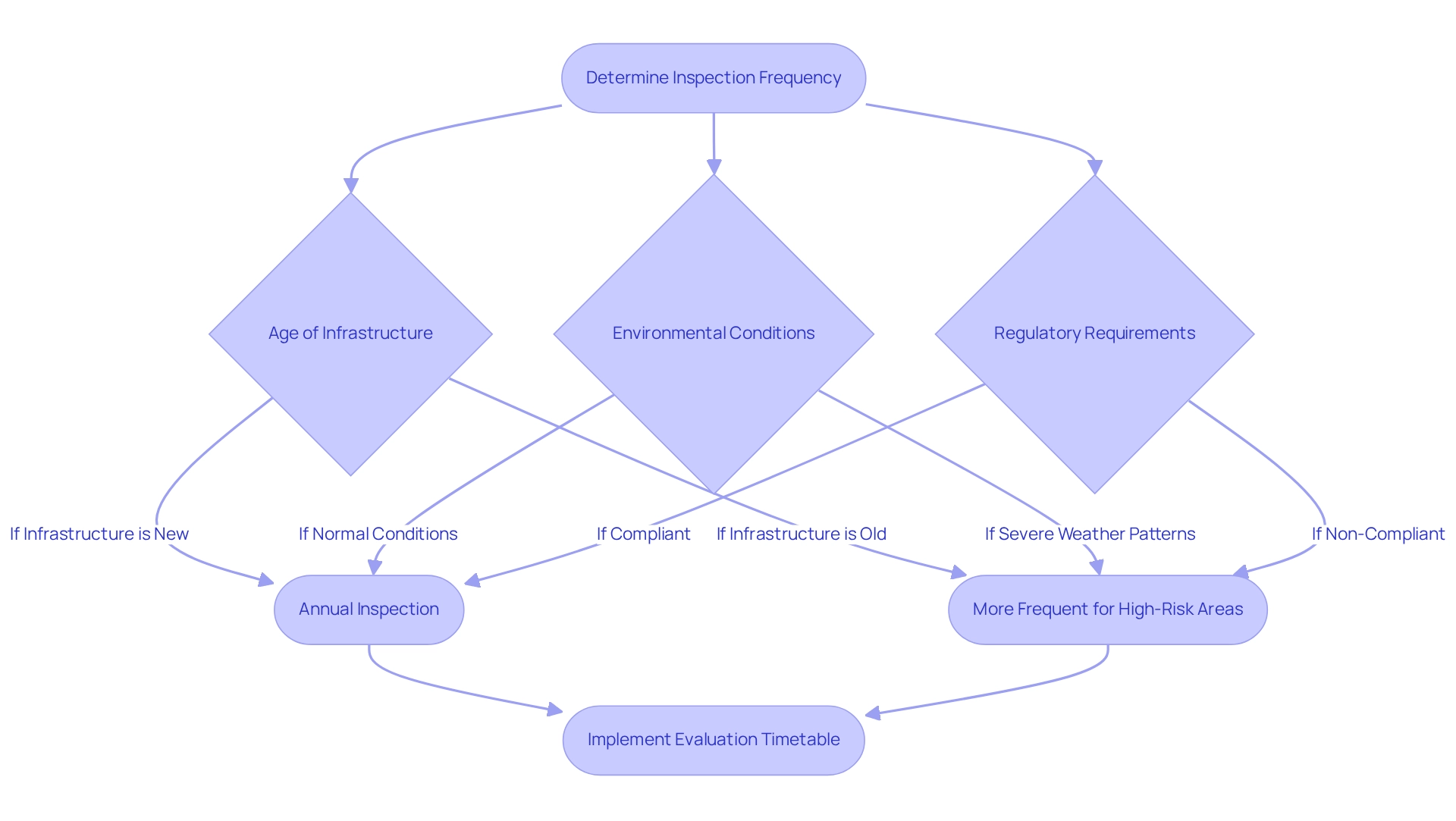
Health Risks: Evaluating the Impact of Living Near High-Voltage Power Lines
Residing near high-voltage power line inspections raises significant concerns regarding potential health risks, particularly from exposure to electromagnetic fields (EMFs). Research findings have been varied; however, some studies indicate a possible link between EMF exposure and specific health issues, notably childhood leukemia. An extensive study conducted in California investigated the connection between childhood leukemia and proximity to high-voltage power line inspections, revealing a marginally increased odds ratio of 1.4 for children born within 50 meters of cables exceeding 200 kV. Notably, no substantial risk was identified at greater distances or with lower-voltage cables, suggesting that while correlation exists, the evidence remains inconclusive.
Statistics further illustrate EMF exposure levels in residential areas near electrical cables. For instance, an educational institution situated merely 34 meters from a high-voltage transmission recorded a magnetic field measurement of 0.16 T. This measurement highlights the potential for increased exposure nearby, although it is crucial to compare it with recognized guidelines to fully comprehend its implications. Despite these findings, the overall consensus emphasizes the need for ongoing research to clarify the relationship between EMF exposure and health outcomes, particularly in vulnerable populations such as children. This examination underscores the necessity for additional inquiry into the relationship between childhood leukemia risk and high-voltage power line inspections.
Utility companies play a crucial role in addressing community concerns by providing transparent information about EMF levels and engaging with residents to foster understanding. Ongoing observation and study are vital to ensure public health, as the effects of EMF exposure remain an active subject of inquiry within the scientific community. As noted by Leeka Kheifets, excluding subjects born in 1996 and those with Down syndrome did not alter the results, emphasizing the importance of considering various factors in these studies.

Key Takeaways: The Importance of High-Voltage Power Line Inspections for Safety and Reliability
High-voltage power line inspections are essential for ensuring the security and reliability of energy infrastructure. These routine evaluations proactively detect potential issues, significantly reducing the risk of outages and enhancing public safety. By adhering to regulatory standards and engaging with local communities, utility companies can effectively manage the risks associated with high-voltage power line inspections. Advanced evaluation technologies, such as drone surveillance and thermal imaging, further bolster high-voltage power line inspections by enabling thorough assessments that guarantee infrastructure integrity.
A proactive evaluation strategy not only fosters trust among stakeholders but also ensures the ongoing reliability of power delivery. For example, effective feeder design and meticulous outage data collection, as illustrated in the case study "Cost-Effective Electrical Distribution Reliability," demonstrate improvements in electrical distribution reliability. This case study highlights that by preventing prolonged outages and utilizing sectionalizing protective devices, utilities can reduce both the frequency and duration of interruptions, ultimately benefiting societal safety and lowering costs.
Statistics indicate that regular monitoring programs can decrease interruption frequency and duration, with studies suggesting a reduction of up to 30% in outage occurrences. As Paul Denholm, a senior research fellow, notes, "The future grid will not resemble today's electrical grid, but it can still provide the dependable electricity that sustains our lives." Therefore, investing in robust strategies for high-voltage power line inspections is vital for the continual enhancement of power line reliability.
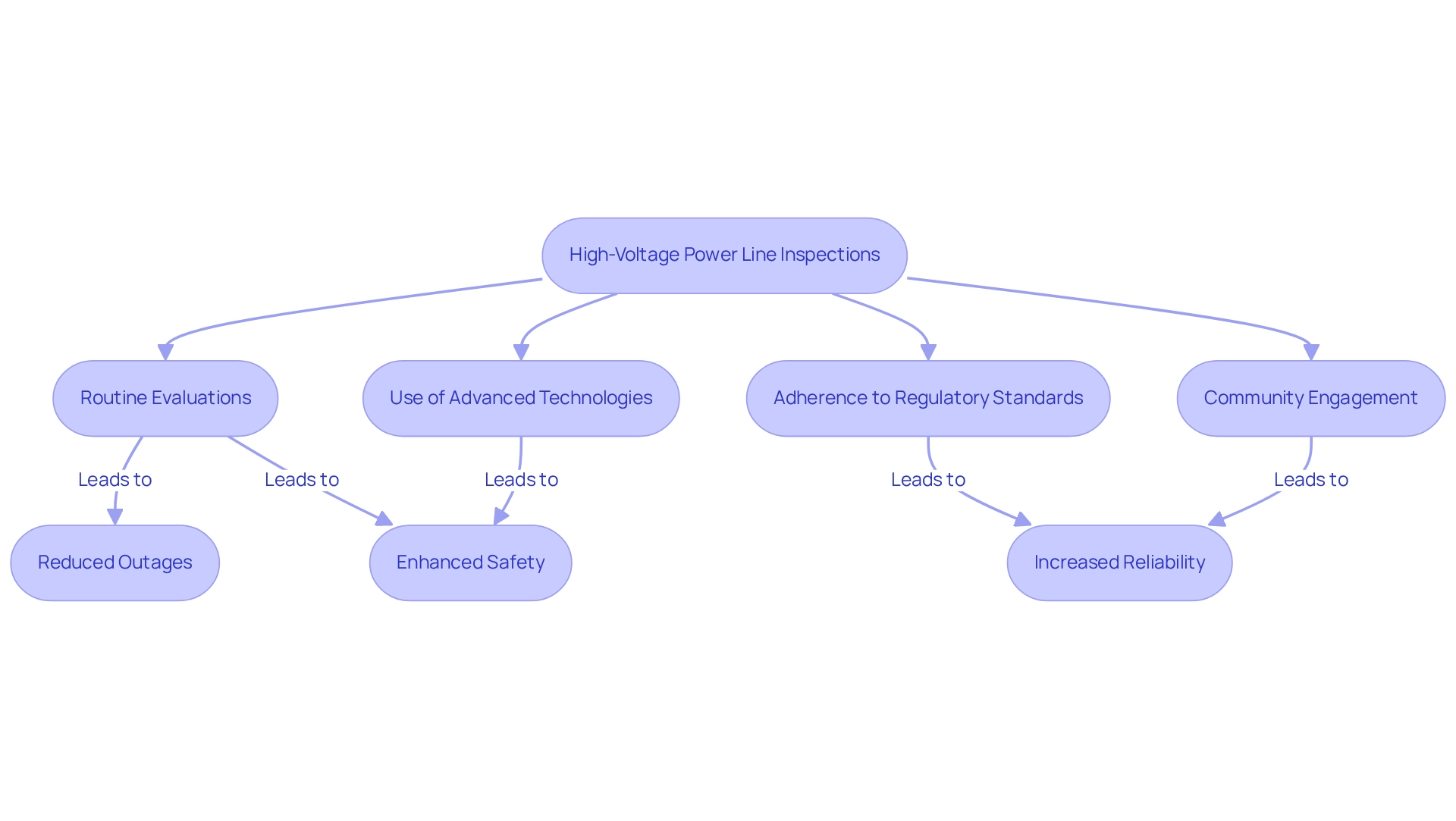
Conclusion
Ensuring the safety and reliability of high-voltage power lines is a critical endeavor that demands attention. Effective tree trimming and vegetation management are essential to prevent hazards that may lead to outages or fires. Compliance with safety regulations is not just important; it is imperative. Additionally, understanding the implications of electromagnetic fields (EMFs) is vital for addressing public health concerns, underscoring the necessity for transparent communication from utility companies.
The innovative application of helicopter inspections utilizing infrared technology marks a significant advancement in monitoring high-voltage power lines. This method enables the swift identification of potential issues that ground inspections may overlook, ultimately enhancing safety and reliability. Furthermore, adherence to regulatory compliance is paramount, as it safeguards public safety and mitigates potential liabilities for utility companies.
Community engagement is crucial in promoting safety awareness and fostering trust between utility companies and residents. By prioritizing communication and education, stakeholders can collaboratively reduce risks associated with high-voltage power lines. As the landscape of energy infrastructure evolves, a steadfast commitment to robust inspection protocols and proactive measures will be essential in maintaining the integrity of our electrical systems and ensuring the well-being of the communities they serve. This collective effort will contribute to a safer, more reliable power delivery system for all.
Frequently Asked Questions
What services does Harbinger Land provide for energy and infrastructure projects?
Harbinger Land offers comprehensive solutions that include title research, GIS mapping, and data processing to assist with land services.
How does Harbinger Land enhance operational efficiency?
Harbinger Land utilizes cutting-edge technology, such as AI-driven title research software, to streamline processes and improve client satisfaction.
Who can benefit from partnering with Harbinger Land?
Natural gas companies, solar developers, and municipalities can benefit from Harbinger Land's expertise in navigating land services.
What is the importance of tree trimming and vegetation management near high-voltage power lines?
Efficient tree trimming and vegetation management are crucial for ensuring safety during high-voltage power line inspections, preventing outages and fire hazards.
What recommendations does Oncor provide for tree planting near power lines?
Oncor recommends planting trees away from existing overhead electric wires to minimize potential conflicts and enhance service reliability.
How does effective vegetation management impact power line inspections?
Effective vegetation management can significantly reduce the frequency of outages related to high-voltage power line inspections, improving overall service reliability.
What are electromagnetic fields (EMFs) and why are they a concern near high-voltage power lines?
EMFs generated by high-voltage cables can impact the surrounding environment and community health, with studies indicating a potential link to childhood cancers.
Why is monitoring EMF levels important for utility companies?
Monitoring EMF levels is essential because these fields can penetrate building materials, necessitating indoor measurements to ensure public health and regulatory compliance.
What role does community engagement play in addressing EMF concerns?
Utility companies should engage with the community through educational initiatives to build trust and inform residents about EMF exposure levels and safety measures.
What are the implications of outdated health guidelines regarding EMFs?
Outdated health guidelines for telecommunications equipment necessitate a comprehensive re-evaluation, as current research suggests potential health risks associated with EMF exposure.
List of Sources
- Harbinger Land | Comprehensive Solutions for Land Services in Energy and Infrastructure
- Leveraging Technology For Efficient Land Acquisition Processes - FasterCapital (https://fastercapital.com/topics/leveraging-technology-for-efficient-land-acquisition-processes.html)
- Optimizing Energy Projects: Land Acquisition and Consulting for Sustainable Development (https://blog.harbingerland.com/optimizing-energy-projects-land-acquisition-and-consulting-for-sustainable-development)
- How Much Land Is Needed for 100% Renewable Energy? (Latest Research Stats) (https://patentpc.com/blog/how-much-land-is-needed-for-100-renewable-energy-latest-research-stats)
- Tree Trimming and Vegetation Management: Ensuring Safety Near High-Voltage Power Lines
- Enhanced tree trimming reduces storm-related power outages, study finds (https://phys.org/news/2019-08-tree-trimming-storm-related-power-outages.html)
- Dynamic modeling of the effects of vegetation management on weather-related power outages (https://sciencedirect.com/science/article/abs/pii/S0378779622000700)
- Vegetation Management (https://oncor.com/content/oncorwww/us/en/home/about-us/vegetation-management.html)
- Understanding Electromagnetic Fields (EMFs) and Their Impact Near High-Voltage Power Lines
- Residential Proximity to High-Voltage Power Lines and Risk of Childhood Hematological Malignancies - PMC (https://pmc.ncbi.nlm.nih.gov/articles/PMC8702367)
- Quotes from Experts | electromagnetichealth.org (https://electromagnetichealth.org/quotes-from-experts)
- Power lines and transformers: Health effects and safe distance (https://home-biology.com/electromagnetic-radiation/low-frequency-electromagnetic-fields/power-lines-and-transformers)
- Helicopter Inspections: Utilizing Infrared Technology for High-Voltage Power Line Safety
- Helicopters, Infrared Technology Used to Complete Proactive Inspections of High-Voltage Power Lines in FirstEnergy Service Area (https://firstenergycorp.com/newsroom/news_articles/helicopters-infrared-tech-used-to-complete-proactive-inspections.html)
- 2022 Power Line Safety and Aviation Report by PR Technologies (https://pr-tech.com/news/power-line-aviation-safety)
- Helicopter-Assisted Power Line Inspections: Boosting Efficiency and Safety – Fair Lifts Helicopter Services (https://fairlifts.com/helicopter-services/transmission-lines/helicopter-assisted-power-line-inspections-boosting-efficiency-and-safety)
- Regulatory Compliance: Key Standards for High-Voltage Power Line Inspections
- utilitydive.com (https://utilitydive.com/news/ferc-grid-reliability-transmission-interconnection-pjm-iso-ne-capacity-market-phillips/702640)
- NERC Standards (https://ferc.gov/industries-data/electric/industry-activities/nerc-standards)
- FERC and NERC Compliance (https://customtruck.com/blog/ferc-and-nerc-compliance)
- Transmission Line Vegetation Management (https://ferc.gov/transmission-line-vegetation-management)
- Identifying Safety Hazards: Common Risks Associated with High-Voltage Power Lines
- High Voltage Electrical Safety - HSI (https://hsi.com/blog/high-voltage-electrical-safety)
- eLCOSH : Power Line Hazard Awareness (https://elcosh.org/document/1679/d000592/Power+Line+Hazard+Awareness.html)
- Overhead Powerline Safety - Electrical Safety Foundation International (https://esfi.org/overhead-powerline-safety)
- Workplace Safety - Overhead Power Line Contact - Electrical Safety Foundation International (https://esfi.org/workplace-safety-overhead-power-line-contact)
- Community Engagement: Promoting Safety Awareness Around High-Voltage Power Lines
- Workplace Safety - Electrical Safety Foundation International (https://esfi.org/workplace-safety)
- Community Engagement Statistics Statistics: ZipDo Education Reports 2025 (https://zipdo.co/community-engagement-statistics)
- What Statistics Indicate the Impact of Community Participation on PPP Project Success? → Question (https://sustainability-directory.com/question/what-statistics-indicate-the-impact-of-community-participation-on-ppp-project-success)
- Inspection Frequency: How Often Should High-Voltage Power Lines Be Inspected?
- Top 5 Power Line Inspection Companies [2025] (https://averroes.ai/blog/power-line-inspection-companies)
- The Facts on Transmission Line Inspections (https://newsroom.edison.com/the-facts-on-transmission-line-inspections)
- Drone Power Line Inspections [Pro Guide] (https://averroes.ai/blog/drone-power-line-inspections)
- Health Risks: Evaluating the Impact of Living Near High-Voltage Power Lines
- Childhood leukaemia and distance from power lines in California: a population-based case-control study - PMC (https://pmc.ncbi.nlm.nih.gov/articles/PMC4931365)
- Proximity to overhead power lines and childhood leukaemia: an international pooled analysis - PMC (https://pmc.ncbi.nlm.nih.gov/articles/PMC6068168)
- Residential magnetic fields exposure and childhood leukemia: a population-based case-control study in California - PMC (https://pmc.ncbi.nlm.nih.gov/articles/PMC5706765)
- Residential Proximity to High-Voltage Power Lines and Risk of Childhood Hematological Malignancies - PMC (https://pmc.ncbi.nlm.nih.gov/articles/PMC8702367)
- Key Takeaways: The Importance of High-Voltage Power Line Inspections for Safety and Reliability
- Top 10 Things To Know About Power Grid Reliability | NREL (https://nrel.gov/news/detail/program/2024/top-10-things-to-know-about-power-grid-reliability)
- Simple Strategies to Improve Power Reliability (https://renewableenergyworld.com/power-grid/outage-management/simple-strategies-to-improve-power-reliability)
- insight-quality.com (https://insight-quality.com/10-quality-quotes)
- TOP 25 INSPECTION QUOTES (of 114) | A-Z Quotes (https://azquotes.com/quotes/topics/inspection.html)




